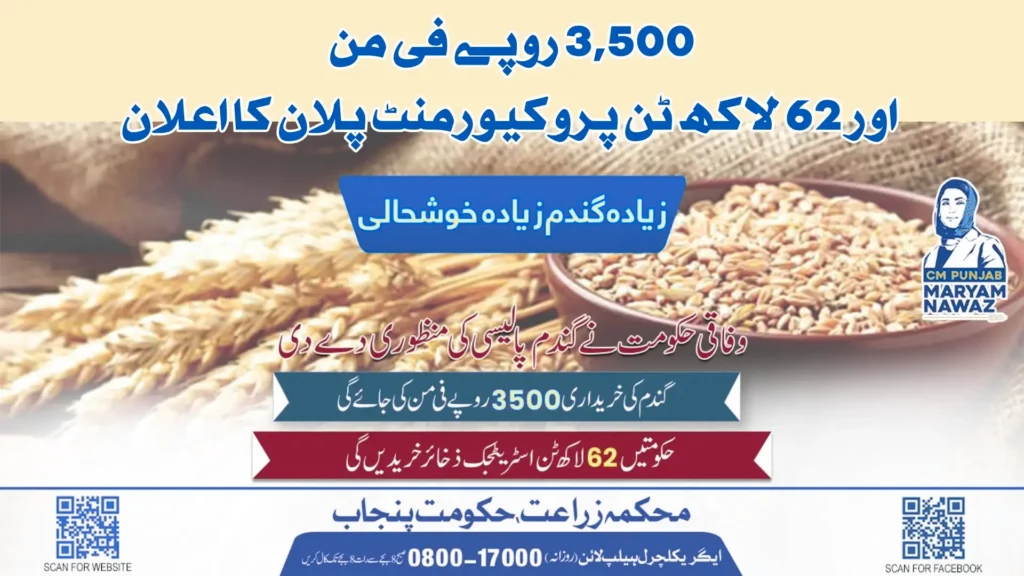
What’s the deal?
The provincial government of Punjab has set the wheat procurement rate at Rs. 3,500 per maund (approximately 40 kg) for the 2025–26 crop season. This move was finalised in a meeting led by Maryam Nawaz Sharif and senior agriculture- and food-department officials. The goal: to give farmers a fair price and stabilise the wheat market.
Why it matters for farmers
Think of it like this: if you grow wheat and you’ll get about Rs. 3,500 for each maund you deliver. That’s one way the government is trying to protect your income.
Here are the key points:
- The procurement price (Rs. 3,500/maund) is aligned with the broader national wheat-policy framework for 2025–26.
- The government says there is no shortage of wheat in Punjab, so supply is adequate.
- The policy also ties to other support measures: in April 2025, a relief package worth Rs. 110 billion was approved for wheat-farmers (Punjab govt).
Key Features of the Policy
Here’s a table summarising the major elements of the policy:
| Feature | Detail |
|---|---|
| Procurement price | Rs. 3,500 per maund (≈ 40 kg) |
| Strategic reserve | ~6.2 million tonnes to be maintained |
| Free movement of wheat | No restrictions on inter-provincial movement under the new policy |
| Farmers’ support package | Rs. 110 billion total package announced April 2025, including direct support |
What this means for you on the ground
- You know ahead of harvest that if you deliver to the recognised channel, you should expect Rs. 3,500 per maund.
- Because the policy includes movement rights (no inter-provincial restrictions), you have more potential buyers.
- The strategic-reserve clause means the government is committed to maintaining stocks, not just chasing price-spikes.
How effectively will it work?
In practice, there are always hitches: transport, storage, quality grades, and the actual “channel” you deliver into. The fact that the price was set after consultation with the private sector is promising. But farmers should still:
- Check which procurement centres are approved (and ensure they accept the Rs. 3,500 rate).
- Make sure your wheat meets the quality standards (moisture, impurities, etc.).
- Confirm payment timelines, you should receive payment promptly after delivery.
- Keep records of how many maunds you deliver and to whom.
Challenges to watch
- If a farmer delivers but the grain is rejected for quality reasons, they might end up getting much less.
- Transport or storage costs may reduce net benefit.
- Some farmers may not get full access if logistics are weak in their area.
- Market-prices for wheat may still fluctuate (downwards or upwards) depending on global trends, though the Rs. 3,500 sets a strong floor.
Quick checklist for farmers
- Confirm your mandi/procurement centre is listed under the policy.
- Check what grade of wheat is accepted at Rs. 3,500.
- Arrange transport in good time.
- Keep crop records: number of maunds harvested, delivered, time of delivery.
- Ask for a payment slip or receipt when you deliver.
Conclusion
If you’re a wheat-farmer in Punjab, this policy offers a clearer pricing landmark and stronger backing than many previous years. The Rs. 3,500 per maund rate presents a realistic floor and the government is positioning the move as part of a larger push for stability and fairness. Still, success depends on what happens on the ground, how smoothly the procurement centres run, how well you as a farmer access them, and how timely payments are made. Stay engaged, keep tabs on your local mandi and delivery process, and this policy could work in your favour. Best of luck for the upcoming harvest.
FAQs
- What exactly is a “maund”?
A standard unit in Pakistan roughly equal to 40 kg for wheat in Punjab. - Is Rs. 3,500 per maund guaranteed for every farmer?
It is the official procurement price under the new policy, but you must deliver through recognised channels and meet quality specs. - Can I sell to any buyer at that rate?
It depends on whether the buyer is part of the procurement scheme recognised by the province. Always verify. - Will I get paid immediately after delivery?
Ideally yes, but payment timelines may vary depending on mandi and payment machinery. Keep records. - What happens if my wheat is rejected for quality?
Then you may receive a lower rate or be asked to re-deliver; quality criteria matter. - Are there storage or transport subsidies too?
Yes, earlier policy packages included support for storage and other inputs. - Does this policy affect flour-mills or only farmers?
It affects both: mills must purchase under public policy and farmers benefit from the procurement price. - What happens to wheat exports under this policy?
The national framework allows free movement and reserves; export may depend on federal rules. - Are small farmers treated differently?
The policy is aimed broadly; whether you are small or large, the price is the same but access and logistics may differ. - Does this policy cover other crops besides wheat?
No, this particular policy is specific to wheat. Other crops have their own policies.




